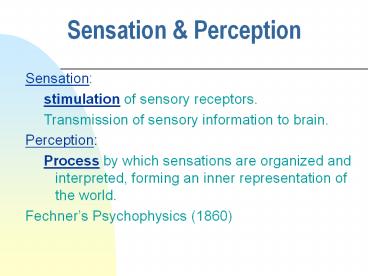Sensation - PowerPoint PPT Presentation
Title:
Sensation
Description:
Sensation & Perception Sensation: stimulation of sensory receptors. Transmission of sensory information to brain. Perception: Process by which sensations are ... – PowerPoint PPT presentation
Number of Views:305
Avg rating:3.0/5.0
Title: Sensation
1
Sensation Perception
Sensation stimulation of sensory
receptors. Transmission of sensory information to
brain. Perception Process by which sensations
are organized and interpreted, forming an inner
representation of the world. Fechners
Psychophysics (1860)
2
Sensation Perception
- Internet Listening General Fun
- Radio Lab (www.wnyc.org)
- Season Two Musical Language, Where Am I?
- http//www.girlsgotech.org/mixed_messages.html
- http//www2.b3ta.com/clickthecolour/
- Learning Objectives
- Vision Taction
- Audition Vestibular
- Olfaction Kinesthesis
- Gustation
3
Psychophysics
- Gustav Fechner
- Elements of Psychophysics 1860
- Considered by many as the true birth of
Psychology as a science. - Psychophysics gap between the physical and
psychological worlds.
4
Sensation Perception
- Sensation
- stimulation of sensory receptors.
- transmission of sensory information to the brain.
- Perception
- Process by which sensations are organized and
interpreted, forming an inner representation of
the world.
5
Overview of the Senses
- Physical Energy Senses
- Vision / Audition / Taction
- Chemical Senses
- Gustation / Olfaction
- Motion-Gravity Senses
6
Vision
Sensing and perceiving light waves Lightwaves
vary in length and amplitude Wave length
affects color perception Wave amplitude affects
brightness Light is the source of all
color. Additive (light) vs. Subtractive (pigment)
7
Vision
- (L)ROY G BIV(S)
- So what colors are missing?
8
Structures of the Eye
- Cornea allows light in
- Iris muscle
- Pupil controls amount of light
- Lens focuses light
- Retina receives information about light
9
Retina
- Inner membrane of eye, receives information about
light using rods cones. - Functions much like the spinal cord acts as an
information superhighway.
10
Rods
- 125 million, rod shaped receptors
- sensitive only to intensity of light
- important for night (very sensitive), and
peripheral vision (many are located on periphery
of retina).
11
Cones
- 6.5 million, cone shaped receptors.
- transmits sensation of colors.
- mostly located around the center of the eye
(fovea). - Important in daylight and color vision.
- Dont work well in dim light.
12
Fovea
- Located near the center of the retina.
- most dense with cones and some rods.
- Vision is most acute,
- where you bring images into focus.
- Fovea means pit
13
Optic Nerve
- Transmits sensory information from eye to brain
(Occipital lobe of cerebral cortex). - Converting physical energy into meaningful
information for the brain. - Critical Thinking Challenge
14
Theories of Color Vision
- Trichromatic Theory
- Afterimage (a problem)
- Opponent-Process Theory
- Trichromat (normal color vision)
- Color Blindness
- Dichromat, Monochromat
15
Visual Perception
- Gestalt Psychologists
- Wertheimer, Kohler, Koffka
- Gestalt rules
- Top-Down Processing
- Bottom-Up Processing
16
Perception of Movement
- Illusions (misperceptions)
- Autokinetic Effect
- Stroboscopic Motion
- Phi-Phenomenon
17
Some Fun Phenomenon
- Attention Cocktail Party Effect
- Stroop Effect
- GREEN / RED
18
3 PARTS OF THE EAR 3 PARTS OF THE EAR 3 PARTS OF THE EAR
PART FUNCTION STRUCTURE(S)
OUTER FUNNELS sound waves Pinnas or Auricles
MIDDLE AMPLIFIES sound waves Eardrum, hammer, anvil, stirrup
INNER TRANSLATES information for brain Cochlea, Basilar Membrane, Organ of Corti, AUDITORY NERVE
19
Hearing Problems
- Conductive Deafness
- Loss of conduction
- Middle ear
- Sensorineural Deafness
- Damage to hair cells
- inner ear
20
Chemical Senses
- Olfaction
- Sampling odor molecules
- Crucial contribution to gustation
- Gustation
- 4 Primary taste qualities
- 10,000 taste buds
21
Taction
- Touch and Pressure
- Temperature
- Pain
- Prostaglandins, Bradykinnin, Substance P
- Gate Theory
22
- Kinesthesis motion
- (kinesis motion, aisthesisperception)
- Vestibular Sense inner ear
- Position relative to gravity.
- Sense of equilibrium.
- ESP Is it sensory info?
- File-Drawer Problem
- Déjà vu Jamias vu































